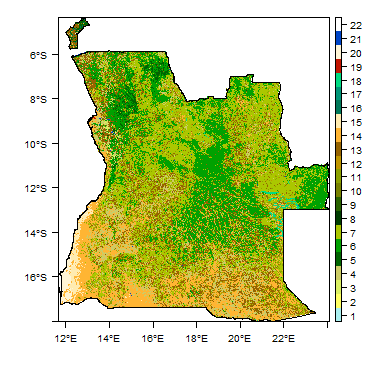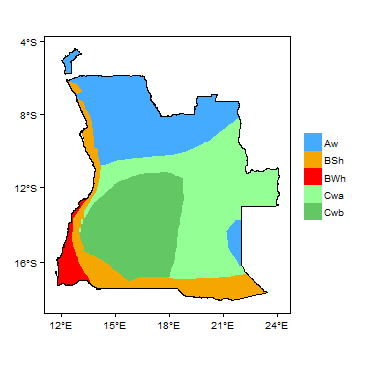Hydrogeology of Angola
Africa Groundwater Atlas >> Hydrogeology by country >> Hydrogeology of Angola
Most of the textual information on this page was taken from the chapter on Angola in the report ‘Groundwater in Eastern, Central and Southern Africa’ (UN 1989).This information is outdated. If you have more recent information on the hydrogeology of Angola, please get in touch.
Compilers
Dr Kirsty Upton and Brighid Ó Dochartaigh, British Geological Survey, UK
Geographical Setting

General
Angola is in central-southern Africa. There is a lowland coastal strip between 35 and 180 km wide that ranges from 300 to 500 m in elevation. Away from this, most of the country is formed of high plateaus from abotu 1000 to 1,800 m in elevation, with the highest point at 2,620 m. Hills and mountains rise inland from the coast into a major escarpment. Extending eastwards and southeastwards from the escarment is is a large area of high plateau (planalto).
| Estimated Population in 2013* | 21,471,618 |
| Rural Population (% of total) (2013)* | 57.5% |
| Total Surface Area* | 1,246,700 sq km |
| Agricultural Land (% of total area) (2012)* | 47.5% |
| Capital City | Luanda |
| Region | Central Africa |
| Border Countries | Namibia, the Democratic Republic of the Congo, Zambia |
| Annual Freshwater Withdrawal (2013)* | 708.8 Million cubic metres |
| Annual Freshwater Withdrawal for Agriculture (2013)* | 20.8% |
| Annual Freshwater Withdrawal for Domestic Use (2013)* | 45.3% |
| Annual Freshwater Withdrawal for Industry (2013)* | 33.9% |
| Rural Population with Access to Improved Water Source (2012)* | 34.3% |
| Urban Population with Access to Improved Water Source (2012)* | 67.6% |
* Source: World Bank
Climate
Most of Angola has a dry season from May to October and a rainy season from February to April, with transitional rains from November to January. The south of the country, and along parts of the coastal strip, are semi-arid, with less than 400 mm/year of rain. The far north sees rainfall throughout much of the year, with more than 1,400 mm/year of rain. The climate is greatly influenced by prevailing winds from the west and southwest.
-
Koppen Geiger Climate Zones
-
Average Annual Precipitation
-
Average Temperature
For further detail on the climate datasets used see the climate resources section.
Surface water
|
The centre and north of Angola have many perennial rivers. In the south there are only three perennial rivers: the Cunene, Kuando and Cubango (which flows to the Okavango) rivers. The Zambezi River and several tributaries of the Congo River have their sources in Angola. Many rivers originate in the central uplands, but take quite different flowpaths. Some flow more or less due westerly to the Atlantic, providing water for irrigation and the potential for hydroelectric power in the dry coastal strip. Two of the largest rivers, the Cuanza and the Cunene, take a more indirect route to the Atlantic, the Cuanza flowing north and the Cunene flowing south before turning west. navigable. The Kwango and other rivers flow north from the high plateau to join the Kasai River (one of the largest tributaries of the Congo). Some rivers flow south into the Zambezi River system and from there to the Indian Ocean; others to the Okavango River (called the Cubango River in Angola) and thence to the Okavango Swamp in Botswana.
|
 |
Soil
 |
Land cover
|
In the far south and southwest of Angola, land cover is dominated by desert or sparse savannah or grassland vegetation. This gives way northwards to shrubland and then to a mix of shrubland then to deciduous forest, which covers much of the rest of the country.
|
 |
Geology
This section provides a summary of the geology of Angola. More information is available in the report‘Groundwater in Eastern, Central and Southern Africa’ (UN 1989) (see References section, below).
The geology map shows a simplified version of the geology at a national scale (see the Geology resources page for more details).

| Key formations | Period | Lithology | |
| Unconsolidated/Semi-consolidated | |||
|---|---|---|---|
| Alluvium | Quaternary | Unconsolidated alluvial sediments infilling valleys. | |
| Tertiary-Quaternary | Kalahari sequence | Loosely consolidated sandstones and unconsolidated sands and silts, covering much of the eastern part of the country. | |
| Coastal basin | |||
| Cenozoic sedimentary rocks | Cretaceous-Tertiary | Up to 150 m thickness of Aptian-Maastrichtian age sedimentary rocks overlain by up to 1,200 m thickness of Palaeocene to Pliocene age sedimentary rocks. | |
| Mesozoic sedimentary rocks | |||
| Karoo Supergroup | Permian-Jurassic | Argillaceous limestones, sandstones and shales at the edge of Congo basin. Up to 500 m thick. Intruded by dolerites. | |
| Precambrian | |||
| Bembé system | Late Precambrian-Lower Cambrian | Schist-limestone series overlain by meta-sandstones, meta-conglomerates and quartzites | |
| Oendolongo system | Precambrian | Quartzitic meta-sandstones | |
| Craton / Crystalline Basement | Archaean | Crystalline igneous and metamorphic rocks, largely a granitogneissic complex. | |
Hydrogeology
This section provides a summary of the hydrogeology of the main aquifers in Angola. More information is available in the report‘Groundwater in Eastern, Central and Southern Africa’ (UN 1989) (see References section, below).
The hydrogeology map shows a simplified version of the type and productivity of the main aquifers at a national scale (see the Aquifer properties resource page for more details).
Unconsolidated
| Named Aquifers | Period | General Description | Water quality |
Sedimentary - Intergranular Flow
| Named Aquifers | Period | General Description | Water quality |
Sedimentary - Intergranular & Fracture Flow
| Named Aquifers | Period | General Description | Water quality |
Sedimentary - Fracture Flow
| Named Aquifers | Period | General Description | Water quality |
Basement
| Named Aquifers | Period | General Description | Water quality |
Groundwater Status
Groundwater quantity
Groundwater quality
Groundwater use and management
Groundwater use
Groundwater management
Groundwater monitoring
Transboundary aquifers
For further information about transboundary aquifers, please see the Transboundary aquifers resources page
References
The following references provide more information on the geology and hydrogeology of Angola.
These, and others, can be accessed through the Africa Groundwater Literature Archive
United Nations. 1989. Groundwater in Eastern, Central and Southern Africa: Angola. United Nations Department of Technical Cooperation for Development, Natural Resources/Water Series No.19, ST/TCD/6.
Return to the index pages
Africa Groundwater Atlas >> Hydrogeology by country >> Hydrogeology of Angola








